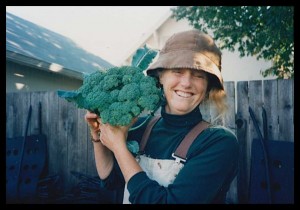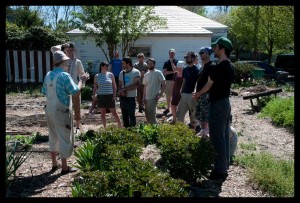The Legacy of Kim McDodge
The Growing of Ariadne Garden: Recollections of Kim McDodge (PDF)
A wonderful book about the history of Ariadne Garden and the legacy of Kim McDodge. Hardcopies available for purchase at Ariadne Garden for $6
The Legacy of Kim McDodge (1946-2011)
by Jhan Hochman
Kim McDodge, who passed on April 5, was founder and leader of Ariadne Garden and an important part of establishing Alberta Cooperative Grocery, loaning it $10,000 to begin operation.

Since 1993, the public face of Kim McDodge has been a place, an organic urban farm nestled in the Sabin neighborhood near NE Fremont and 11th called Ariadne Garden. McDodge, until her death on April 5, was the garden’s visionary founder and scientifically inquiring manager, buying the land, deeding it to the Oregon Sustainable Agriculture Land Trust (OSALT), and transforming it into a non-garden variety volunteer-staffed, organic, urban farm.
Happening upon it, it is startling: stretching over two full residential lots (10,000 square feet) and fronted by a stand selling the garden’s bountiful fruit, vegetables, and flowers, the place looks out of place—almost rural. But it also seems out of time, a throwback to and harbinger of small agriculture and backyard production.
Kim McMillan was born in Minneapolis at the confluence of three wealthy families, one branch which joined with Cargill, this country’s largest private corporation. After attending Wells College and earning a B.F.A. from the University of Minnesota, Kim came to Portland in 1970, worked various jobs, and developed an interest in Carl Jung (1875-1961), which in 1974, led her to become an early member of the Oregon Friends of Jung. Jung’s exploration of the labyrinth (and Ariadne’s threading clue/clew) must have nicely reverberated with the Hopi maze design of mother and child which Kim selected for Ariadne’s layout.
In the mid-eighties, Kim worked for the Sabin Community Land Trust. She stated that she became attracted to land trusts because:
“With the community land trust model, a community can buy the land under houses. People then could buy the houses for a little bit less money because the community still owned the land and made decisions about that land in an ecological framework. It was structured so the house was there for a family in a long-term, equity lease, with lots of incentives to fix things up. I was very drawn to this idea as one of a flock of ideas that could be utilized in new societal constraints or an ecological emergency that could be imposed by the toxic effects of chemicals in our world” (McDodge Memoir, ed. Kay Reid).
Kim also studied gardening: “In the 1980s, I was influenced by Bio-intensive, John Jeavons’ work of Ecology Action down in the Bay Area. This non-profit organization teaches people how to feed themselves while they simultaneously nourish the soil and conserve resources” (Memoir).
In 1993, with a $10,000 inheritance, Kim purchased the 10,000 square feet that would become Ariadne, and in 1995, deeding it to OSALT, the first property in OSALT’s collection of eight. “It was important for me to put the Garden in trust. I knew that it took a while to work the soil of any spot to a generative state, especially in a city, and I wanted the Garden plot protected against building development” (Memoir).
Kim then got deep into soil. With her husband-collaborator, Terence Dodge, she took classes in soil biology from Dr. Elaine Ingham, a professor in Botany and Plant Pathology at Oregon State University (now president of Soil Foodweb) and began sending Ariadne’s soil samples to Dr. Ingham’s lab. McDodge said that Ingham “researches the organisms in the soil and on the foliage of our plants, looking at which organisms benefit which types of plants, which organisms are good for and which harm plants, and how to maintain soil fertility” (Memoir).
Ariadne is now a radically organic garden: unlike many organic operations, it never uses even organically acceptable pesticide, herbicide, or fertilizer. Instead Ariadne adds only its own compost (weeds and food scraps, sometimes organically enriched), turned cover crops (winter Austrian field peas, rye, crimson clover, summer buckwheat), woody matter, and occasionally, chicken manure. If Ariadne has a problem with pests, it simply stops growing the particular crop and works on improving the soil until a more propitious planting.
Ariadne is a self-sustaining retailer, selling its own flowers (peonies, roses, yarrow, lilies, gladiola, zinnias) and produce (tomatoes and starts, lettuces, escaroles, mustards, kales, beans, squash, raspberries, etc.) to neighbors and passersby and paying its volunteer gardeners with its bounty.
McDodge’s cultivation, however, did not stop with land, food, soil, and a cadre of volunteers. Kim also grew community in a spot where community might never have developed:
 “I live across the street from the garden in which Kim spent many hours. I know Kim to be a kind and loving person, she gives everyone a chance. What I mean is her garden feeds a lot of elderly people at no cost to them. My son has special needs and, understanding, Kim always had a helping word. Kim would put him to work teaching him along the way that everything he did in the garden wasn’t for her but for others. It made him feel good to know he was helping.”
“I live across the street from the garden in which Kim spent many hours. I know Kim to be a kind and loving person, she gives everyone a chance. What I mean is her garden feeds a lot of elderly people at no cost to them. My son has special needs and, understanding, Kim always had a helping word. Kim would put him to work teaching him along the way that everything he did in the garden wasn’t for her but for others. It made him feel good to know he was helping.”
And:
“I met Kim through the garden when I moved into Sabin neighborhood ten years ago. I was recovering from a serious auto accident so my being was slow; body, speech and mind. I would go on Tuesdays and Saturdays when the garden was open with Kim welcoming me and finding me something I could do. Our relationship grew through numerous activities of the garden . . . . Her acceptance of me, sharing her knowledge and allowing me to contribute how I could all contributed in great ways to my physical and mental recovery.”
Before the mortal Ariadne more famously enabled Theseus to kill the minotaur and escape the labyrinth, she was a Minoan vegetation goddess celebrated by rituals reflecting the death and revival of the vegetation she personified. Kim elegantly fused these two Ariadne’s in her garden-labyrinth, becoming remarkably Ariadne-like herself by showing the rest of us at least one way to kill the minotaur of corporate agriculture, thread our way out of the labyrinth of supermarket aisles, and find our way back to the mazing paths of an organic garden.
